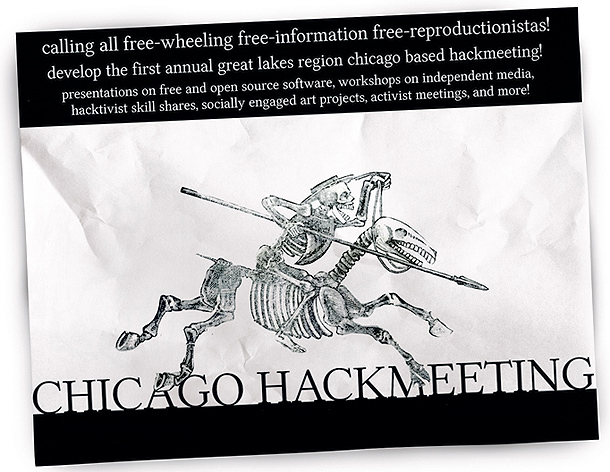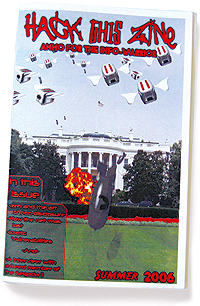
The first Chicago Hackmeeting convened in the back of an old flower shop in Pilsen last October. Flyers advertised it as an event for "free-wheeling free-information free-reproductionistas," "activists that just want to share resources," and "militant media makers." This translated to a mostly male crowd of about 30 or so tech enthusiasts, anarchists, political activists, and Art Institute students, who lounged around on old couches. When conversation lulled, some hoodie-wearing geeks fiddled at their keyboards, playing an online form of Capture the Flag with friendly hackers at concurrent meetings in Barcelona and Santiago.
A man wearing dreadlocks named Ben Buckley moderated the gathering. A member of the Chicago chapter of Free Geek, an organization that teaches people how to recycle and refurbish computers, Buckley asked each person there to announce his personal politics and address a question: "What is the relationship between the work we do with computers, and the work we do in the real world, smashing the system with direct action?" When it came time for a 22-year-old named Jeremy Hammond to talk, his blue eyes lit up. "All conflict comes from social inequality and those who use this to their advantage," Hammond said, growing more impassioned with each word. Citing dependence on oil, overpopulation, and climate change as heralds of the end of comfy first-world capitalism, he continued: "Our civilization is facing a radical, imminent mass change. The alternative to the hierarchical power structure is based on mutual aid and group consensus. As hackers we can learn these systems, manipulate these systems, and shut down these systems if we need to."
It wasn't just bravado. Even those who had met Hammond only online knew he was one of the most notorious Chicago "hacktivists," a loose term that refers to activists across the political spectrum who have taken their fight to the Internet. At the time, he likely was headed to federal prison for breaking into the Web site of a conservative group called Protest Warrior and stealing its members' credit card numbers and other information. Instead of seeming chastised by the potential of jail, he appeared energized.
That evening, I caught up with Hammond in front of the flower shop. He bragged about a current scheme involving Kinko's cards, which he had hacked so they would grant free copies. He fanned the cards in front of me as if he were performing a magic trick. Then he pulled from his pocket a San Francisco Bay Area Rapid Transit pass. "I can clone these so easily," he boasted.
If the police had known that Hammond had spent the day teaching hacking to anyone who wanted to learn, they probably would have thrown him in jail, since, as part of his bail agreement five months before, he wasn't supposed to go near computers. Not to mention that he was smoking joints, despite court-ordered drug tests while he awaited sentencing. But Hammond was the type who seemed to relish what he was facing. "I've wanted to play an electronic Robin Hood," he said. "If you're going to play this game, you've got to be willing to pay."
The word "hacker" conjures up visions of geeky teenagers who steal identities and credit cards, who wield technical knowledge to sow mayhem and chaos. But in the computer world, a hack is simply a quick, intelligent solution to a technical problem. People who call themselves hackers may use their knowledge to cripple Web sites ("black hats") or protect them ("white hats"). What they all have in common is that they try to stretch the boundaries of what computers can do.
What, then, is a hacktivist? People who call themselves hacktivists have crippled the Web site of the World Trade Organization. Groups like Electronic Disturbance Theater have staged virtual sit-ins-when volunteers use FloodNet software to knock an opposition organization offline-to support the Zapatista movement in Mexico. In Chicago, anonymous hacktivists sent CTA cardholders a spoof e-mail addressed from then-CTA president Frank Kruesi, offering free fares and apologizing for future service cuts. Essentially, anything a traditional protester can do-from sit-ins, to graffiti, to general civil disobedience-can be done online.
But not all hacktivists agree with such tactics. "Hacktivism by our definition has certain rules," says Oxblood Ruffin, a Munich-based member of one of the oldest hacker organizations, the Cult of the Dead Cow, which takes credit for coining the term "hacktivist." "If you don't follow those rules then you're . . . often committing a crime." Ruffin's group writes software that lets dissidents communicate anonymously and gives them tools to circumvent the censoring of Web content by authoritarian regimes like those of China and Saudi Arabia. In his eyes, 21st-century hackers have a responsibility to safeguard the independence and openness of the Internet.
On the South Side of Chicago, a hacktivist named David Eads helped some 30 people at Stateway Gardens housing project build their own computers and introduced them to open-source software that they could freely copy. "The problem isn't fundamentally access to technology," says Eads, describing what differentiates hacktivism from more mainstream nonprofit efforts to cross the digital divide. "It has more to do with rights regarding software, copyright, intellectual property, globalization. And it's attempting to be more connected to communities on a street level, a grassroots kind of model."
Eads became interested in technology while studying at North Park University. He learned how to use the sophisticated operating system Linux and other free programs. But right now he studies new hacking techniques on Hackthissite.org. "I am interested in using information technology as a form of civil disobedience," he says. "Like when you sign an SBC contract, you're not allowed to share your Internet with anybody. I bought a really nice package and share it with everyone in my building. I think at the Chicago level, hacktivism is more about that kind of stuff."
By then, I already knew that the person who started the popular Hackthissite.org was Jeremy Hammond. In Chicago, at least, all roads seemed to lead back to him.

Jeremy Hammond first became interested in computers as an 11-year-old in suburban Glendale Heights. He refuses to talk much about his childhood, but his father, Jack Hammond, a self-described guerrilla filmmaker, music producer, and guitar teacher who still lives in Glendale Heights, was more willing to share. "The guy who worked in Little League with us had a computer business; he showed Jeremy a few things, and Jeremy caught the bug," Jack Hammond says. Jeremy's talents landed him the job of league secretary; he created programs to sort and rate players, and, by 13, was coding databases from scratch.
Hammond's parents, who never married, split up around 1993. His mother, Rose Collins, moved and started a new family, leaving Jeremy and his twin brother, Jason, in the care of their father. With Jack Hammond bringing home about $35,000 a year, plus the monthly child support sent by their mother, the family became "the world champs of living inexpensively and well."
As a child, Jeremy was obsessed with taking things apart, while his twin brother plucked away at the guitar. When the family got its first computer, Jeremy created his own online games. "He was in advanced-placement classes in high school," his father recalls. "He won a district science award-first place for a computer program, of course."
What pushed Jeremy toward more radical behavior was the U.S. invasion of Iraq in 2003. On the day the U.S. forces invaded, Jeremy encouraged 200 or so of his fellow students at Glenbard East to walk out of class, get on the train, and head to the Loop to join larger antiwar protests; remarkably, he did it with the approval of the school administration. "When you have students get up and leave classrooms, that is an aggressive move," says Robert McBride, the principal of Glenbard East. "People recognized [Jeremy] as a student who had quite a bit of moxie. He struck me as old beyond his years, mature enough to work with the administration to have [the walkout] run smoothly."
"He had such a good relationship with the administrators. They tolerated him as long as he stayed in bounds," his father says.
After graduation, Jeremy attended UIC for a year and a half before being asked to leave for vandalizing a campus building and for drug possession. And while he continued for a semester at the College of DuPage, he never finished. Instead, he became more connected to a worldwide community of hackers through Hackthissite.org, and a companion magazine he started called Hack This Zine.
As the list of Hammond's online activities grew, so did a lengthy real-world rap sheet. According to court records, he was arrested ten times between ages 18 and 21 and charged with disorderly conduct and property damage during protests. Another 2006 disorderly conduct charge stemmed from his attempt to incite a riot after chalking a sidewalk outside an Elmhurst Walgreens with the words "While you are shoppin' / Bombs are droppin'."
Serious trouble started in February of 2005, when Kfir Alfia, the administrator and cofounder of a Web site called Protest Warrior, contacted the FBI. Alfia's site is a popular destination for Bill O'Reilly–watching Web surfers, who contribute to a battery of conservative causes and shop in the online store for T-shirts that say "Except for ending slavery, fascism, Nazism, and communism, war has never solved anything."
Alfia told the FBI that his site had been hacked and that its users' credit card numbers and contact information had been stolen. What's more, Alfia claimed, he knew who had done it. (This was familiar territory: a Protest Warrior member had once been accused of hacking into liberal-leaning sites.) A disgruntled former compatriot of Jeremy Hammond's could link him to the break-in; evidence consisted of logs of online chats in which Hammond asked how to make donations to the American Civil Liberties Union on the stolen cards.
In an interview with the FBI, Hammond admitted he had hacked the Protest Warrior site and considered using the card numbers. He told the FBI that it "would be helping people under the thought of ‘Let's steal from the rich to give to the poor.'" Although Hammond never charged anything on the cards (he claims he changed his mind; the government contends he just couldn't figure out how), the prosecution sought five years in prison and a $2.5-million fine-$500 for each of the 5,000 credit cards that were stolen.
The case was a slam dunk for the government. Assistant U.S. attorney Brandon D. Fox, the prosecutor, says it is unusual to receive insider help from another hacker, and that, as a result, the trail of electronic evidence linking Hammond to the crime was considerable. "While Jeremy Hammond tried to make this about politics, we wanted to make this about what actually occurred, that he stole credit cards," said Fox. "I hope with prosecutions like Jeremy Hammond, which certainly got a lot of publicity in the hacker world, people see what can occur if you steal information or assets. You're going to be looking at a prison sentence."
One night at Filter, a coffee shop in Wicker Park, Hammond and I sat among tables of people tapping away at their laptops. He rationalized his actions with mangled quotations from the 1960s radical Weatherman, Plato's Republic, and 9/11 conspiracy theories. He finally admitted that if he had focused on civil disobedience instead of downright theft, he might have had more of a lasting impact and stayed out of jail. "They are going to rob me of some of the best years of my life," he said, his knee bouncing anxiously.
In the end, Hammond threw himself on the mercy of the court and pleaded guilty to breaking into a computer system "and obtaining information," a felony offense. He was ordered to pay $5,358 to Protest Warrior and sentenced to two years in a medium-security federal prison in Greenville, Illinois, about 50 miles from St. Louis. Assuming good behavior, he will probably serve 20 months of his two-year sentence. After prison, his three-year probation agreement prohibits his involvement with hacker or anarchist groups until 2011, when he will be 26.

In December, a week before Hammond reported to prison, I saw him one last time at the Happy House, a dingy two-flat co-op in Pilsen that he was temporarily calling home. Spray-painted anarchist symbols covered the walls, as did slogans like "Bomb the System" and "Fuck the New World Order." Instructions posted next to the front door cautioned what to do if the cops knocked (don't let them in).
The night was billed as a monthly party, but it was also Hammond's final hurrah. I found him standing in the kitchen, watching the heavy-metal band in the next room. He was wearing the same drab brown ski hat and paint-splattered black hoodie he always wore. A tuft of blond-fringed brown hair peeked out from underneath, and his bright blue eyes darted between the band and me as he talked. In a few days he was going to prison, but tonight the mini fridge in the kitchen was stocked with Busch beer and homemade hard cider.
He bragged nervously about an ongoing hack that some friends were up to against the National Socialist Movement, a neo-Nazi group he had protested in Toledo in 2005. They were scanning the group's e-mails and files looking for evidence of hate crimes; if they found anything, they were going to publicize it. He claimed he wasn't involved and said he wouldn't talk more about it-with good reason. It was pretty much the same stunt that was sending him to federal prison.
Hammond had served five months when I talked to his father again. He said prison had been neither violent nor threatening, since most of the other inmates were drug offenders or white-collar criminals. "It's not like The Shawshank Redemption; nobody is trying to kill each other," Jack Hammond said. Jeremy was reading books from the prison library and had a subscription to the Chicago Tribune. The weekly care packages sent from home contained copies of 2600, a hacker quarterly. He was polishing his guitar skills, teaching math and GED preparation to other inmates, and playing baseball for the prison's summer league, his father said. "He's immersing himself in the total prison experience."
Asked if he was proud of Jeremy, his father said yes, mentioning all the ways his son had helped the poor, whether by refurbishing old computers and bikes and giving them away or Dumpster diving to help feed the homeless. "Not that I agree with everything Jeremy does, but his social conscience, his empathy for people, his values are right where they should be. He's an engaged young man," he said. "How many 19- and 20-year-olds are really doing that?"
Before we hung up, Jack Hammond said his son was already thinking about life post-prison. A computer company had been nosing around with a job prospect for when Jeremy was released, which will happen in a little more than a year. Meanwhile, guards were allowing him a little time on the computers in the prison library. The machines, his father pointed out, aren't connected to the Internet.


